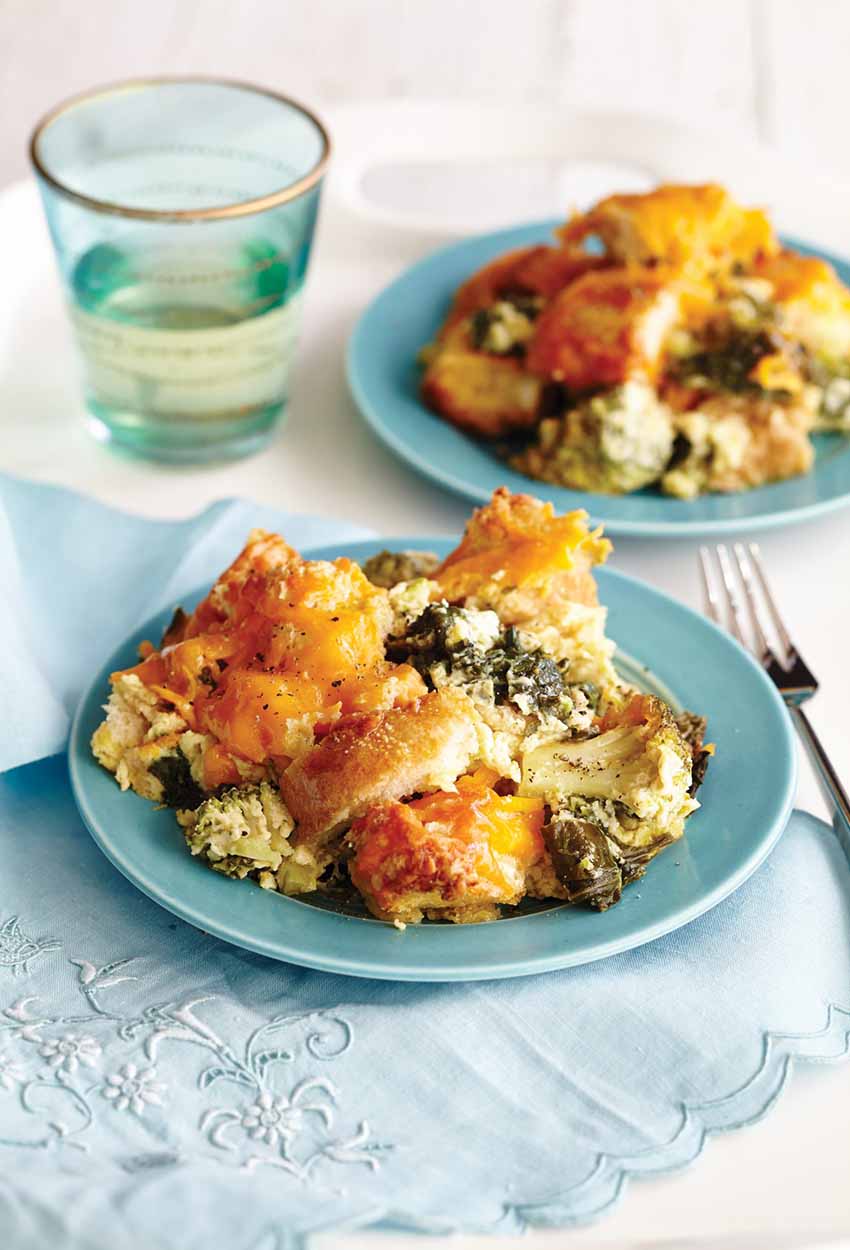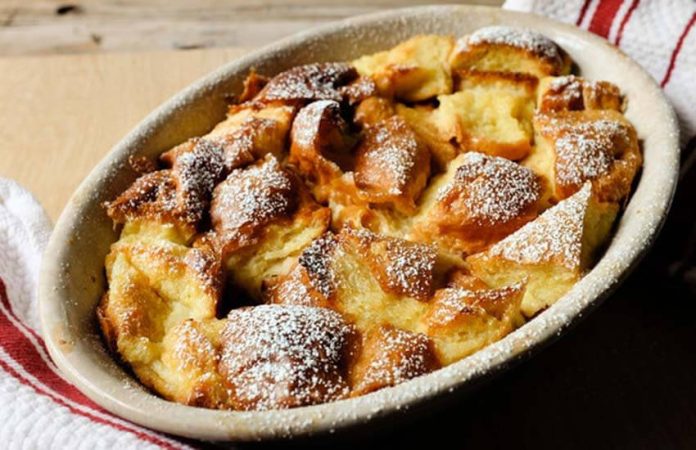Some kitchen problems are universal, and what to do with stale bread is one of those.
In Italy, they came up with strata and budi; in England, it’s “the poor man’s pudding.” Spain and Mexico have capirotada.
Whatever you call it, bread pudding is eaten all over the world, albeit with slightly different ingredients.
Traditional Mexican bread pudding is quite different than what I’m used to, though; it includes cheese — aged and sharp cotija, creamy, melty asadero or even a light queso fresco. That’s part of its Moorish heritage.
The word capirotada originates from capirote, the name of a tall conical hat worn by penitents of an extremist Catholic sect during the Inquisition in Spain. (The hat has holes for the eyes and covers the face and allowed the flagellants to remain anonymous. It was later adopted by the American Ku Klux Klan as part of its ominous uniform.)
At any rate, the bread pudding, so named because of its humble main ingredient of stale bread and the symbology representing the body and blood of Christ, was brought across the ocean by Spanish conquistadores.
There are several variations on Mexican capirotada. Blanca (white), is made with more milk and white sugar, and oscura (dark) is sweetened with piloncillo (unrefined brown sugar). Some recipes call for frying the bread first, but most call for stale bread cut into cubes.
Although supposedly Good Friday and during Lent are the traditional times to serve it, I find it more common here in Mazatlán during the cool winter months. While peanuts, almonds and raisins are customary, there’s no reason not to experiment with other dried fruits and nuts.
Stale bread works best; if using fresh, toast it first or let it sit out for a day to dry out somewhat.
Simple Traditional Capirotada
- 1¼ cups grated piloncillo or packed brown sugar
- 1¼ cups water
- 2 (3-inch) cinnamon sticks
- 4½ cups cubed bolillos or other soft white bread (can be stale)
- ¼ cup raisins
- ¼ cup slivered almonds, toasted
- ¼ cup toasted peanuts, chopped
- 2 Tbsp. butter, in small pieces
- ¾ cup cotija or grated Chihuahua cheese

Combine first three ingredients in saucepan; bring to a boil. Reduce heat; simmer 10 minutes. Discard cinnamon sticks.
Combine bread, raisins, nuts and butter in a bowl. Drizzle with warm sugar syrup, mixing gently. Spoon mixture into 8-inch square baking dish coated with cooking spray. Top with cheese. Cover with foil; chill 30 minutes or up to 4 hours. Bake at 350 F for 20 minutes. Uncover and bake additional 15 minutes or until cheese is golden brown. Serve warm.
Basic Bread Pudding
If you can find a sweet egg bread like brioche or challah, this pudding will be especially rich. Otherwise, use whatever soft white bread that’s available.
- 2 cups milk
- 2 Tbsp. butter
- 1 tsp. vanilla
- ⅓ cup sugar
- Pinch salt
- 5-6 cups sweet egg bread like challah or brioche, in 2-inch cubes
- 2 eggs, beaten
In a saucepan over low heat, warm milk, butter, vanilla, sugar and salt. Continue cooking just until butter melts; set aside to cool. Meanwhile, butter a 4- to 6-cup baking dish and fill it with the cubed bread.
Whisk eggs into the cooled milk mixture; pour over bread. Bake at 350 F for 30–45 minutes or until custard is set but still wobbly and the edges of bread have browned. Serve warm or at room temperature.
Tres Leches Bread Pudding
This is baked in a hot water bath like a custard.
- Butter for greasing baking dish
- 3 eggs
- 4 egg yolks
- 1 cup heavy cream
- 1 cup condensed milk
- 1 cup whole milk
- 1 (12-oz.) can evaporated milk
- 2 tsp. vanilla
- ½ tsp. salt
- About 8 cups brioche or other soft white bread, cut into 1½-inch cubes
Heat the oven to 350 F. Butter 9-inch square baking dish. In large bowl, beat eggs and egg yolks until combined. Whisk in 1 cup heavy cream, ¾ cup condensed milk, the whole milk, evaporated milk, vanilla and salt.
Spread bread in prepared dish; pour egg mixture on top. Press bread down gently with spatula so all pieces are immersed in liquid. Let stand at room temperature 10 minutes.
Bring a kettle of water to a boil. Drizzle 2 Tbsp. condensed milk over the pudding. Cover baking dish tightly with aluminum foil, then set it inside a large roasting pan. Pour boiling water into the roasting pan about halfway up sides of baking dish.
Bake until center of pudding is almost set but still slightly wet, about 25 minutes. Remove foil and bake about 30 minutes more until set in center and top is golden. Carefully remove roasting pan from oven; let pudding cool in the water about 20 minutes. Drizzle with remaining 2 Tbsp. condensed milk. Serve warm, cool or cold.
—nytimes.com
Goat Cheese and Broccoli Bread Pudding
- Butter for greasing baking dish
- 6-8 cups stale baguette, bolillo or other bread, crusts removed
- 1½ cups milk
- 2-4 garlic cloves
- ½ lb. broccoli crowns, cut in small florets
- 2-3 Tbsp. olive oil
- 2 tsp. fresh thyme or 1 tsp. dried
- 1 cup (about 4 oz.) goat cheese, crumbled
- 4 eggs
- Salt and pepper to taste
Rub bread slices, front and back, with cut cloves of garlic. Cut bread into cubes. Place in bowl and toss with 1 cup of the milk. Set aside. Butter baking dish.

In large bowl, beat eggs and goat cheese; add remaining milk. Add salt and pepper, then add the soaked bread and any milk remaining in the bowl. Mix gently. Let sit 15–30 minutes.
Mince any remaining garlic. Steam or microwave broccoli until crisp-tender.
Heat 1 Tbsp. oil over medium heat in skillet. Add garlic, half the thyme, broccoli and a bit of salt and pepper. Stir and cook for 2 minutes, remove from heat and stir into bread mixture.
Scoop bread mixture into baking dish. Sprinkle with remaining thyme, salt and pepper; drizzle on remaining tablespoon of oil. Bake at 350 F for about 50 minutes until puffed, set and lightly browned.
Janet Blaser is the author of the best-selling book, Why We Left: An Anthology of American Women Expats, featured on CNBC and MarketWatch. She has lived in Mexico since 2006. You can find her on Instagram at @thejanetblaser.
